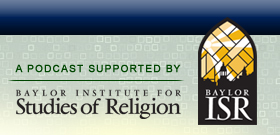

|
Philip Jenkins on Religion & World War I  Date: August 17th, 2014
 Please visit our extensive archives with over 200 episodes on a wide variety of topics, and “like” us over at our Facebook Fan Page for weekly updates and other tidbits. Was “The Great War” a holy war? Noted historian Philip Jenkins, Distinguished Professor of History at Baylor University, joins us to discuss the spiritual overtones and undertones of World War I and that conflict’s impact on our contemporary religious landscape. While most historians have focused on secular and materialist explanations for the war’s outbreak and progression, Prof. Jenkins points out the blind spot his profession has had to the spiritual dimensions of the “war to end all wars.” We begin our discussion with a general survey of World War I’s causes and why historians have emphasized materialistic explanations. It doesn’t take long before Philip is relaying the dense theological imagery and language that set the tone for this war. We also discuss the general spiritual milieu of the times, noting that even though industrialization and urbanization were churning along at a rapid pace, and secular ideologies were all the rage, it was a time of great spiritual ferment. Particularly in Germany and Russia, there were strong messianic tones to the language of politics and military affairs. It was a time of a “culture war” that pitted secular critics against state churches, and orthodox theologies against newer and more esoteric faiths, such as the theosophy. While scholars have overlooked this, Philip notes that the evidence for this was hiding in plain sight. He notes how many important figures of the time (e.g., Generals Ludendorff and von Moltke) were heavily influenced by spiritualism, be it more traditional Christianity or notions of the occult. Our conversation then turns to the war itself and how religious language and imagery was used. We look at the constant discussion of angels and “God’s guiding hand,” perhaps best represented by the story of the Angel of Mons and how that developed. Philip points out how a major German offensive was named Operation Michael, after the biblical archangel. The art of the time was replete with winged women or war heroes, as well as crucifixion scenes that depicted fallen soldiers. We also examine apocalyptic imagery and the recurrence of Armageddon themes, particularly with the British successfully taking the Holy Land in the Battle of Meggido. Philip also explains that even though such religious depictions ran across all economic classes and were quite popular, political and church leaders tried at times to tamp it down for a variety of sensitivities. For example, calling the war a “crusade” was seen as counter-productive in attempting to woo Muslim soldiers into fighting for the Allies. The last portion of our conversation discusses the lasting impacts of WWI on the global religious landscape. We start with Philip explaining a particularly intriguing phrase from his book — “The sleep of religion brings forth monster.” (Prof. Jenkins notes that this is a play on Francisco Goya’s famous line about the sleep of reason.) He points out that the two nations that used religious imagery most intensely during the war — Germany and Russia — gave birth to two of the most secular and horrific ideologies just decades later in the form of Nazism and Soviet communism. One of the continuities between these two eras was the anti-Semitic tone of the ideological rhetoric. This in turn leads us to a discussion of how the fortunes of Judaism were changed with the Balfour Declaration, and how the collapse of the Islamic caliphate (in the form of the Ottoman Empire) influenced events to this day. We also touch upon how global Christianity, most notably in Africa, was given a large boost during the WWI era as the influenza pandemic that spread around the world prompted prophetic healing movements and how this helped to indigenize Christian proselytizing. We finish off the interview with some of Philip’s thoughts on the parallels between today and the past. He sees similar patterns, particularly with respect to the often-ignored conflict in the South China sea and warns about “sleepwalking into catastrophe.” Recorded: August 6, 2014. (Note: The interview was cut a bit short as we had some difficult connecting via Baylor’s phone lines. It was the first day of individual football ticket sales and the phone lines were inundated. Sic ’em Bears!)
RELATED LINKS Philip Jenkin’s bio at Baylor’s Institute for Studies of Religion. Philip Jenkin’s Wikipedia page (just in case he is curious). The Great & Holy War: How World War I Became a Religious Crusade, by Philip Jenkins. Laying Down the Sword: Why We Can’t Ignore the Bible’s Violent Verses, by Philip Jenkins. The Next Christendom: The Coming of Global Christianity, by Philip Jenkins. Jesus Wars: How Four Patriarchs, Three Queens, and Two Emperors Decided What Christians Would Believe for the Next 1,500 Years, by Philip Jenkins. The Lost History of Christianity: The Thousand-Year Golden Age of the Church in the Middle East, Africa, and Asia, by Philip Jenkins. Visit Prof. Jenkins’s Amazon.com page for additional titles. RELATED PODCASTS Philip Jenkins on Global Christianity. Ani Sarkissian on Politics and Religious Civil Society in Turkey. Jim Papandrea on the End of the World and Revelation. James Felak on Pope Pius XII, the Wartime Pontiff.
One Response to “Philip Jenkins on Religion & World War I” |
 Search The Podcast
To search the podcast, type a term and click the Search button.
  Browse Podcast Categories
Select a category below to browse the podcast:
   |















[…] Philip Jenkins on Religion & World War I – Research On Religion […]